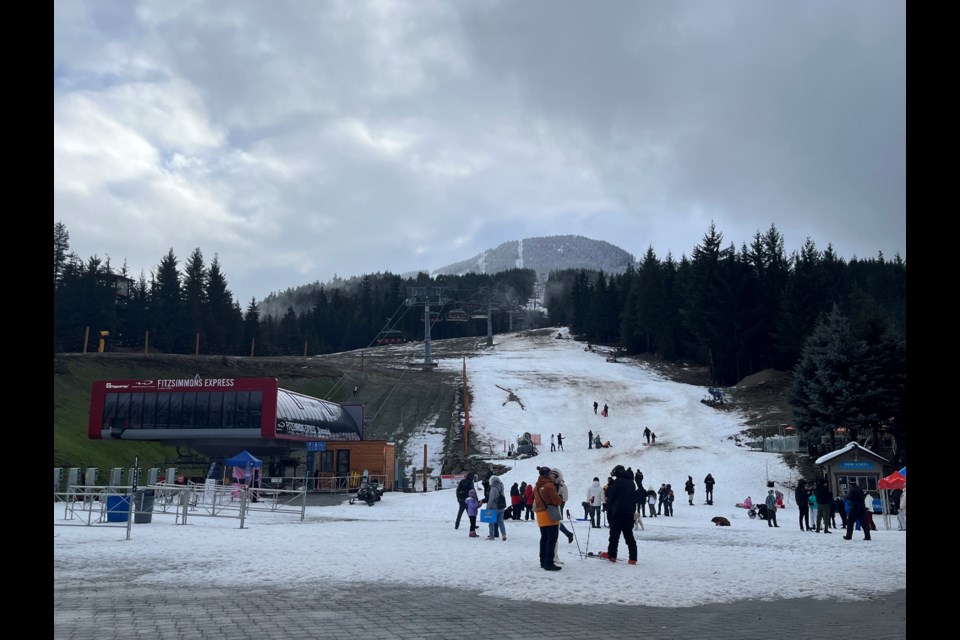It hasn’t been the dream start to the winter season in Whistler, but Whistler Blackcomb (WB) officials are still hopeful the weather will come through.
“We are optimistic cooler valley temperatures and snowfall will return to our ski area,” said WB’s manager of mountain operations, Adam Francis.
“We will capitalize on any cold temperature windows and produce artificial snow, and expect natural snowfall to augment our snow … production to open more areas shortly.”
As of Dec. 21, 38 per cent of WB’s terrain is open, a little under a month after opening day.
The weather hasn’t been all that great since then, with what little snow the valley floor has seen mostly rained out, limiting ski-out conditions.
Further up, conditions are better, with 2,000 acres of terrain to ski on, while the forecast is showing colder temps on the horizon.
“The forecast is calling for a snowmaking window from Friday 22nd after ski out to Monday 25th midday,” said Francis.
“We will have all 354 snow guns poised and ready to maximize production during this production timeframe, including guns placed on all four ski-out zones. This production will help fortify existing ski-outs and also build base on unopened ski-out areas. The exact date to finish and mark ski-outs is unknown.”
Francis said that, while the start of the 23-24 season was warmer and drier than a typical year, “we certainly have had similar early low snow startups in prior years that delivered favourable snow accumulation amounts into the new year.
“We have a long season ahead of us, and are expecting typical snow levels to develop and support our operations through our expected finish.”
Senior manager of communications with WB, Dane Gergovich, asked guests to be patient with mountain operations as conditions change.
“Forecasts are projecting cooler temperatures with substantial snowfall occurring largely on Monday (Dec. 24).
“While this is encouraging, it may present some challenges to our Patrol and Mountain Ops teams as they work hard to open up terrain, especially given the recent milder temperatures and rain we have received.”
Gergovich encouraged those coming to Whistler to plan ahead by using as many of the resources available to guests as possible: The WB website, the WB app, DriveBC for road conditions, and the weather forecast.
“Use them and always bear in mind that conditions on-mountain and in-resort can change,” he said.
According to Environment Canada, Christmas Day is expected to see rain in Whistler. Whistler Blackcomb is a little more optimistic, with its forecast calling for temperatures in the negatives—but with no snow accumulation over the weekend.
The optimism that the early-season conditions won’t hold extends to Tourism Whistler.
“We would all love to see more snow as we head into the busy holiday period next week, but unfortunately we can’t control the weather,” said Tourism Whistler’s manager of communications, Lauren Everest.
“The slow start to the season in terms of natural snowfall has actually demonstrated Whistler’s strengths. While many ski areas around B.C. had to delay their openings this year, Whistler Blackcomb was able to open as planned on Nov. 23 thanks to its extensive snowmaking infrastructure. And as a resort, Whistler also offers many great weather-independent activities so we have the ability to deliver a positive guest experience regardless.”
Everest said the weather conditions experienced so far aren’t a standard for Whistler, but a slow start “is not unusual, and it is not an indication of how the entire season is going to play out.
“For example, we experienced below average snowfall in November and December during the 19-20 season, and then we saw a record-setting January. Everything can change with one good storm cycle.”
Weather so far aside, Tourism Whistler is forecasting visitor numbers in the 23-24 season to be similar to 22-23, which was back up to pre-pandemic visitation numbers.
“We are seeing a lot of strength from B.C. and Canada, and while some of our key international markets have been slower to rebound than originally expected (for example, the U.K. and Australia), we are anticipating growth from the U.S. and Mexico markets this winter,” said Everest.




